Topics
Category
Era
European American Women at Fort Snelling, 1819–1858
Washing tubs, boards, and dolly pins used by interpreters at Historic Fort Snelling to teach visitors about the fort’s laundresses. Photo by Bobbie Scott, 2012.
When the Fifth Infantry Regiment came west in 1819 to build a fort on the bluff where the Mississippi and Minnesota Rivers flow together, some of the soldiers brought their wives and daughters with them. Women and girls made up around 20 percent of the fort’s population from the time of the first census in 1849 until at least 1900. They included the wives and daughters of officers but also lower-class women (wives and daughters of enlisted men, as well as their servants).
The army was divided into two castes: officers and enlisted men. The two groups did not interact casually, and there were even separate hours in the sutler’s store to ensure the two groups wouldn’t come in contact. This division extended to their wives as well; officers’ wives did not socialize with the wives of enlisted men, although they could use them as servants, laundresses, or midwives.
Officers’ wives organized the social events that structured life in the officer class at army forts, including parties, balls, and Sunday school classes. Lower-class women at the fort—wives of enlisted men—were working women. They were usually married to non-commissioned officers (corporals and sergeants). These women worked as laundresses for enlisted men, as servants for officers, or as hospital matrons (essentially laundresses for the hospital).
The 1825 army regulations stated that women could be hired at a rate of three to a company, and one to a detachment or party of seventeen men. They also stated that laundresses would wash the soldiers’ clothes, and that the soldiers would pay the laundresses at a rate determined by the fort’s Council of Administration, which was made up of officers. Sometimes laundresses were paid by the piece, according to the number of items they washed for each soldier.
We don’t know how much the laundresses at Fort Snelling were paid in the 1820s, but we know that at Fort Atkinson in Nebraska during the same time period they were paid fifty cents a month by each soldier whose clothes they washed. If they washed for seventeen soldiers, they could earn $8.50 a month. A sergeant earned eight dollars a month, so laundresses made a major economic contribution to their families. Laundresses also received one food ration per day, straw and firewood, and permission to use the doctor at the post. They were subject to military discipline and could be court martialed (e.g., for talking back to officers or selling liquor to soldiers).
Some women worked as servants for officers. Officers were allowed to draw the pay and rations of one private to compensate them for one private servant. As a result, women who were servants for officers received five dollars per month in the 1820s, just like privates in the army.
The labor pool at Fort Snelling in the 1820s and 1830s was small. Women servants were either the wives of enlisted men or the women who had fled the Selkirk settlement near modern Winnipeg and settled near the fort. Selkirkers Barbara Ann Shadecker and Olympia (no known last name) both worked for Colonel Josiah Snelling and his wife, Abigail. (The Snellings and other officers and officials, including Lawrence Taliaferro, also had unpaid enslaved people working in their households, especially in the 1820s and 1830s. Two of the most famous were Dred and Harriet Scott.)
The 1825 Army regulations allowed two hospital matrons per regiment or one to a post. A hospital matron earned six dollars a month and received one ration a day. We know the name of only one woman who served as a hospital matron in the early years of the fort: Mary Whaley, who gave birth to the youngest of her four children, Daniel, at the fort in 1826. It’s unclear from military records whether her husband, Lester Daniel Whaley, was ever at Fort Snelling, but we know he deserted his family.
Another example of desertion comes from around 1850. The September 1850 census for the fort shows a Jeremiah Mahoney, soldier, with wife Eliza and children William and “Maryon.” Military records show that Mahoney was an ordnance sergeant. The census doesn’t list an occupation for Eliza, but she could have been a laundress. She married, or at least had two children by, William Sloan, a surgeon in the army. Her children William and Marian were born in 1843 and 1845. There is no record of a divorce, but in 1848 she married Mahoney in St. Louis. By 1852 she had left him as well and ended up in Santa Fe with her children. She traveled the Santa Fe trail several times and died in Los Angeles in 1905.
While we know the basic outlines of the lives of European American women at Fort Snelling, we have yet to discover most of their stories. It remains clear that these women—the wives of officers and enlisted men—survived challenging circumstances far away from the cities of the East.
Bibliography
Adams, Barbara Ann Shadecker. “Early Days at Red River Settlement, and Fort Snelling.” Collections of the Minnesota Historical Society 6 (1894): 75–115.
https://archive.org/details/earlydaysatredri00adamrich/page/n4/mode/2up
“An Act to Repeal Certain Acts Respecting the Organization of the Courts of the United States; and for Other Purposes.” Seventh Congress, Sess. I, Ch. 8, 9, 1802.
https://www.loc.gov/law/help/statutes-at-large/7th-congress/session-1/c7s1ch9.pdf
Lawrence, Jennifer J. Soap Suds Row: The Bold Lives of Army Laundresses, 1802–1876. Glendo, WY: High Plains Press, 2016.
Scott, Bobbie. “Charlotte Ouisconsin Clark Van Cleve.” MinneCulture In Depth, KFAI radio, 2012.
https://beta.prx.org/stories/78155
Snelling, Henry Hunt. Memoirs of a Boyhood at Fort Snelling. Edited by Lewis Beeson. Minneapolis: N.p., 1939.
Stallard, Patricia Y. Glittering Misery: Dependents of the Indian-Fighting Army. Norman, OK: University of Oklahoma Press, 1992.
Stewart, Miller J. “Army Laundresses: Ladies of the ‘Soap Suds Row.'” Nebraska History 61 (1980): 421–436.
https://history.nebraska.gov/sites/history.nebraska.gov/files/doc/publications/NH1980ArmyLaundresses.pdf
United States War Department. “Dress—Personal Cleanliness and Neatness.” Section II, Article 28 of General Regulations for the Army, or, Military Institutes, 47–48. Philadelphia: M. Carey and Sons, 1821.
https://collections.nlm.nih.gov/bookviewer?PID=nlm:nlmuid-0255000-bk#page/64
United States War Department. “Issues to Women.” Section 1147, Article 72 of General Regulations for the Army, or, Military Institutes, 308. Washington, DC: Davis and Force, 1825.
https://collections.nlm.nih.gov/bookviewer?PID=nlm:nlmuid-0255001-bk#page/328
Van Cleve, Charlotte Ouisconsin Clark. Three Score Years and Ten: Life-Long Memories of Fort Snelling, Minnesota, and Other Parts of the West. Minneapolis: Harrison & Smith, 1888.
http://www.gutenberg.org/ebooks/20232
Related Resources
Secondary
Helmbold, Lois Rita, and Ann Schofield. "Women's Labor History, 1790–1945." Reviews in American History 17, no. 4 (1989): 501–18.
Eichner, Katrina Christiana Loening. “Queering Frontier Identities: Archaeological Investigations at a Nineteenth-Century U.S. Army Laundresses' Quarters in Fort Davis, Texas.” PhD diss., University of California, Berkeley, 2017.
https://digitalassets.lib.berkeley.edu/etd/ucb/text/Eichner_berkeley_0028E_17010.pdf
Web
National Army Museum. Family Life: Soldiering Wives.
https://www.nam.ac.uk/explore/victorian-soldiering-wives
Related Images
This metal thimble was found in 1968 during excavation of the sutler’s store at Historic Fort Snelling. Thimbles appear in the store's inventories from the 1830s. They could have been used by the women at the fort (laundresses, domestic servants, enslaved women, and officers' wives) or by the company tailors.
Two fragments make up a lead toy soldier that is flat, almost two dimensional. One small piece has broken off, but the fragments form an otherwise complete object. The soldier is wearing a large hat and a coat with tails and is holding a firearm—possibly a musket—perpendicular to his body and leaning on his shoulder. This toy was found during the excavation of the hospital building at Historic Fort Snelling in 1974.
This sterling silver baby spoon has a handle that curves back on itself completely, forming a loop. The word 'baby' is written on it in raised lettering. The bowl has the words "Hey diddle diddle" and a scene depicting the actions described in the Mother Goose rhyme: "Hey diddle diddle, the cat and the fiddle / The cow jumped over the moon / The little dog laughed to see such sport / And the dish ran away with the spoon." The spoon was found in 1971 during excavation of the southeast wall line at Historic Fort Snelling. The excavation trench ran from the South Battery (also known as the Hexagonal Tower) to the officers' latrines. This area was used as a dump and contained a wide variety of artifacts
Straight pins found in 1971 during excavation of the southeast wall line at Historic Fort Snelling. The excavation trench ran from the South Battery (also known as the Hexagonal Tower) to the officers' latrines. This area was used as a dump and contained a wide variety of artifacts.
The common pin or straight pin made from iron wire or, more commonly, brass wire, dates from the medieval period and later. It wasn’t until the 1840s that straight pins could be mass produced; at that time, most straight pins came from England. The presence of these pins at Fort Snelling demonstrates the fort's participation in a global economic system even when it was one of the westernmost outposts of the United States. Records of the fort's sutler’s store from the 1830s don't mention pins, but they do mention needles and thimbles. These pins have not been dated, but they are made from two pieces of wire, one forming the shank and the other twisted to form the head.
This very small (two centimeters wide) porcelain figural toy is a type of "Frozen Charlotte" doll associated with the character Charlotte in the American folk ballad "Fair Charlotte," popular between 1850 and 1920. This doll was found during excavation of Apartment D in the officers' quarters at Historic Fort Snelling in 1976. Accession 377.4.81.2, archaeology collection, Minnesota Historical Society.
Stoneware bottle created between 1846 and 1866. It has been refitted from multiple sherds and was found during excavation of the walled cnclosure behind the sutler's store at Historic Fort Snelling in 1969.
This bottle has a circular seal stamped just below the shoulder. On it the word "SELTERS" surrounds the image of a crowned lion standing on its hind legs. Stamped below this are the words "HERZOGTHUM NASSAU." These marks identify the former contents as mineral water from the Niederselters spring in the Duchy of Nassau, located in the modern state of Hesse Germany. The spring produced naturally carbonated water, and by the late eighteenth century, it was bottled and exported worldwide. By the nineteenth century it was so well known that one of our generic terms for carbonated water—seltzer—derives from Selters. During this period, mineral water was widely regarded as an effective cure for a host of ailments.
A number of sherds fit together to form this complete plate with a blue transfer print design depicting a goat standing on a cliff. The central scene is surrounded by a scroll and floral border. The backmark is impressed, not printed, and reads, “Enoch Wood & Sons / Burslem”. Enoch Wood brought his sons into his business in 1818, and Enoch died in 1840, giving a date range for the plate of 1818–1840. The pattern is part of the Sporting Series.
The sherds were found in 1971 during excavation of the southeast wall line at Historic Fort Snelling. This excavation trench ran from the south battery (also known as the Hexagonal Tower) to the officers' latrines. This area was used as a dump and contained a wide variety of artifacts.
Reconstructed quarters (representing ca. 1827) for enlisted men and their families at Historic Fort Snelling. The bunks shown here would have served two different families, with the mothers and fathers sleeping together in the lower bunks and their children sleeping above. Photo by Bobbie Scott, 2012.

Washing tubs, boards, and dolly pins at Historic Fort Snelling
Washing tubs, boards, and dolly pins used by interpreters at Historic Fort Snelling to teach visitors about the fort’s laundresses. Photo by Bobbie Scott, 2012.
All rights reserved
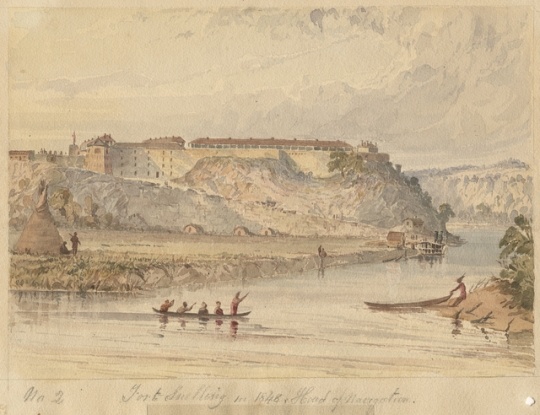
Fort Snelling
Painting of Fort Snelling viewed from the intersection of the Minnesota and Mississippi Rivers (Bdote). Watercolor on paper by Seth Eastman, 1848.
Holding Location
More Information
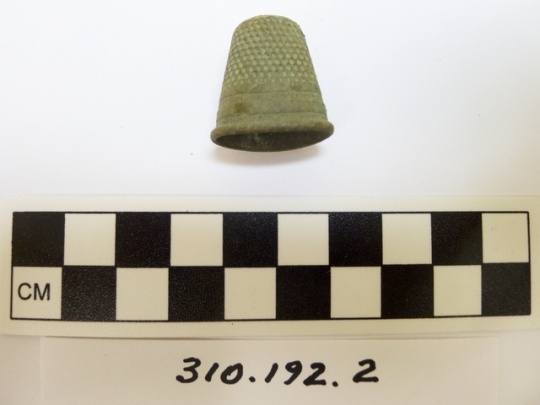
Thimble
This metal thimble was found in 1968 during excavation of the sutler’s store at Historic Fort Snelling. Thimbles appear in the store's inventories from the 1830s. They could have been used by the women at the fort (laundresses, domestic servants, enslaved women, and officers' wives) or by the company tailors.
All rights reserved
Holding Location
More Information
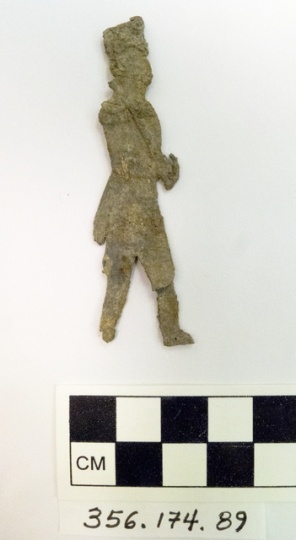
Lead toy soldier
Two fragments make up a lead toy soldier that is flat, almost two dimensional. One small piece has broken off, but the fragments form an otherwise complete object. The soldier is wearing a large hat and a coat with tails and is holding a firearm—possibly a musket—perpendicular to his body and leaning on his shoulder. This toy was found during the excavation of the hospital building at Historic Fort Snelling in 1974.
All rights reserved
Holding Location
More Information
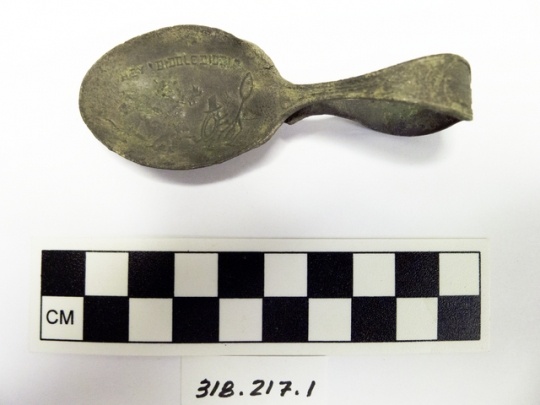
Baby's or toddler's spoon
This sterling silver baby spoon has a handle that curves back on itself completely, forming a loop. The word 'baby' is written on it in raised lettering. The bowl has the words "Hey diddle diddle" and a scene depicting the actions described in the Mother Goose rhyme: "Hey diddle diddle, the cat and the fiddle / The cow jumped over the moon / The little dog laughed to see such sport / And the dish ran away with the spoon." The spoon was found in 1971 during excavation of the southeast wall line at Historic Fort Snelling. The excavation trench ran from the South Battery (also known as the Hexagonal Tower) to the officers' latrines. This area was used as a dump and contained a wide variety of artifacts
All rights reserved
Holding Location
More Information
.jpg)
Straight pins
Straight pins found in 1971 during excavation of the southeast wall line at Historic Fort Snelling. The excavation trench ran from the South Battery (also known as the Hexagonal Tower) to the officers' latrines. This area was used as a dump and contained a wide variety of artifacts.
The common pin or straight pin made from iron wire or, more commonly, brass wire, dates from the medieval period and later. It wasn’t until the 1840s that straight pins could be mass produced; at that time, most straight pins came from England. The presence of these pins at Fort Snelling demonstrates the fort's participation in a global economic system even when it was one of the westernmost outposts of the United States. Records of the fort's sutler’s store from the 1830s don't mention pins, but they do mention needles and thimbles. These pins have not been dated, but they are made from two pieces of wire, one forming the shank and the other twisted to form the head.
All rights reserved
Holding Location
More Information
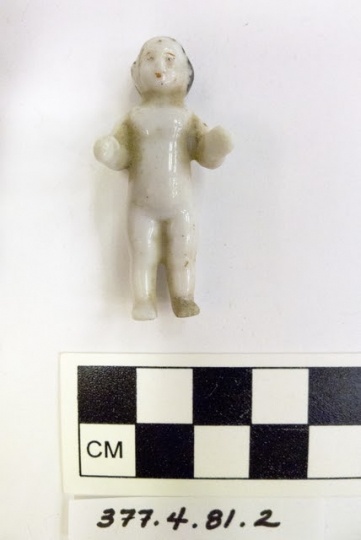
Frozen Charlotte doll
This very small (two centimeters wide) porcelain figural toy is a type of "Frozen Charlotte" doll associated with the character Charlotte in the American folk ballad "Fair Charlotte," popular between 1850 and 1920. This doll was found during excavation of Apartment D in the officers' quarters at Historic Fort Snelling in 1976. Accession 377.4.81.2, archaeology collection, Minnesota Historical Society.
All rights reserved
Holding Location
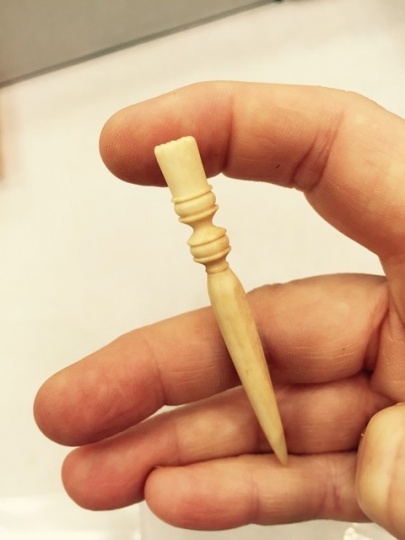
Lace-making bobbin
Bone bobbin used in lace making. Excavated from the officers' quarters at Historic Fort Snelling in 1977. Accession 377.6.117.1, archaeology collection, Minnesota Historical Society.
All rights reserved
Holding Location
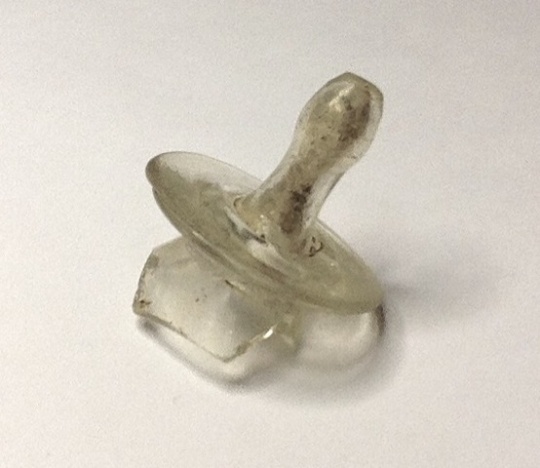
Glass nipple
Glass nipple, possibly from a nursing bottle, found during excavation of the wood barracks (long barracks) at Historic Fort Snelling in 1973. Accession 343.213.19, archaeology collection, Minnesota Historical Society.
All rights reserved

Stoneware bottle
Stoneware bottle created between 1846 and 1866. It has been refitted from multiple sherds and was found during excavation of the walled cnclosure behind the sutler's store at Historic Fort Snelling in 1969.
This bottle has a circular seal stamped just below the shoulder. On it the word "SELTERS" surrounds the image of a crowned lion standing on its hind legs. Stamped below this are the words "HERZOGTHUM NASSAU." These marks identify the former contents as mineral water from the Niederselters spring in the Duchy of Nassau, located in the modern state of Hesse Germany. The spring produced naturally carbonated water, and by the late eighteenth century, it was bottled and exported worldwide. By the nineteenth century it was so well known that one of our generic terms for carbonated water—seltzer—derives from Selters. During this period, mineral water was widely regarded as an effective cure for a host of ailments.
All rights reserved
Holding Location
More Information

Ceramic plate
A number of sherds fit together to form this complete plate with a blue transfer print design depicting a goat standing on a cliff. The central scene is surrounded by a scroll and floral border. The backmark is impressed, not printed, and reads, “Enoch Wood & Sons / Burslem”. Enoch Wood brought his sons into his business in 1818, and Enoch died in 1840, giving a date range for the plate of 1818–1840. The pattern is part of the Sporting Series.
The sherds were found in 1971 during excavation of the southeast wall line at Historic Fort Snelling. This excavation trench ran from the south battery (also known as the Hexagonal Tower) to the officers' latrines. This area was used as a dump and contained a wide variety of artifacts.
All rights reserved
Holding Location
More Information
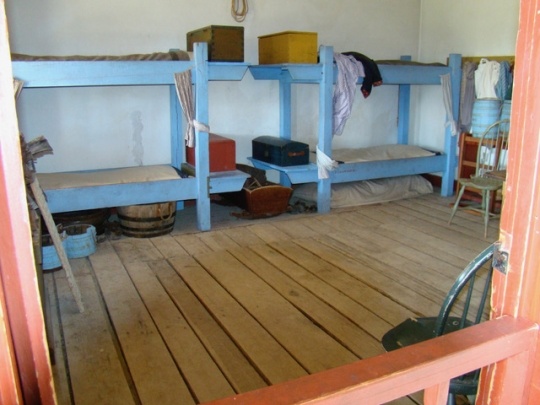
Reconstructed quarters for enlisted men with families at Historic Fort Snelling
Reconstructed quarters (representing ca. 1827) for enlisted men and their families at Historic Fort Snelling. The bunks shown here would have served two different families, with the mothers and fathers sleeping together in the lower bunks and their children sleeping above. Photo by Bobbie Scott, 2012.
All rights reserved
Related Articles
Turning Point
In 1819, the Fifth Infantry Regiment arrives at the intersection of the St. Peters (Minnesota) and Mississippi Rivers, called Bdote by the Dakota. Some enlisted men bring their wives, daughters, and female servants with them.
Chronology
1802
1819
1820
1821
1825
1825
1825
1826
1849
1858
1861
1888
1946
Bibliography
Adams, Barbara Ann Shadecker. “Early Days at Red River Settlement, and Fort Snelling.” Collections of the Minnesota Historical Society 6 (1894): 75–115.
https://archive.org/details/earlydaysatredri00adamrich/page/n4/mode/2up
“An Act to Repeal Certain Acts Respecting the Organization of the Courts of the United States; and for Other Purposes.” Seventh Congress, Sess. I, Ch. 8, 9, 1802.
https://www.loc.gov/law/help/statutes-at-large/7th-congress/session-1/c7s1ch9.pdf
Lawrence, Jennifer J. Soap Suds Row: The Bold Lives of Army Laundresses, 1802–1876. Glendo, WY: High Plains Press, 2016.
Scott, Bobbie. “Charlotte Ouisconsin Clark Van Cleve.” MinneCulture In Depth, KFAI radio, 2012.
https://beta.prx.org/stories/78155
Snelling, Henry Hunt. Memoirs of a Boyhood at Fort Snelling. Edited by Lewis Beeson. Minneapolis: N.p., 1939.
Stallard, Patricia Y. Glittering Misery: Dependents of the Indian-Fighting Army. Norman, OK: University of Oklahoma Press, 1992.
Stewart, Miller J. “Army Laundresses: Ladies of the ‘Soap Suds Row.'” Nebraska History 61 (1980): 421–436.
https://history.nebraska.gov/sites/history.nebraska.gov/files/doc/publications/NH1980ArmyLaundresses.pdf
United States War Department. “Dress—Personal Cleanliness and Neatness.” Section II, Article 28 of General Regulations for the Army, or, Military Institutes, 47–48. Philadelphia: M. Carey and Sons, 1821.
https://collections.nlm.nih.gov/bookviewer?PID=nlm:nlmuid-0255000-bk#page/64
United States War Department. “Issues to Women.” Section 1147, Article 72 of General Regulations for the Army, or, Military Institutes, 308. Washington, DC: Davis and Force, 1825.
https://collections.nlm.nih.gov/bookviewer?PID=nlm:nlmuid-0255001-bk#page/328
Van Cleve, Charlotte Ouisconsin Clark. Three Score Years and Ten: Life-Long Memories of Fort Snelling, Minnesota, and Other Parts of the West. Minneapolis: Harrison & Smith, 1888.
http://www.gutenberg.org/ebooks/20232
Related Resources
Secondary
Helmbold, Lois Rita, and Ann Schofield. "Women's Labor History, 1790–1945." Reviews in American History 17, no. 4 (1989): 501–18.
Eichner, Katrina Christiana Loening. “Queering Frontier Identities: Archaeological Investigations at a Nineteenth-Century U.S. Army Laundresses' Quarters in Fort Davis, Texas.” PhD diss., University of California, Berkeley, 2017.
https://digitalassets.lib.berkeley.edu/etd/ucb/text/Eichner_berkeley_0028E_17010.pdf
Web
National Army Museum. Family Life: Soldiering Wives.
https://www.nam.ac.uk/explore/victorian-soldiering-wives







.jpg?width=200&height=200&name=318%20(1).jpg)





